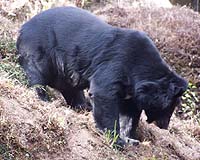| . |  |
. |
Arlington TX (SPX) Oct 01, 2010 Biologists from The University of Texas at Arlington have uncovered virus fragments from the same family of the modern Hepatitis B virus locked inside the genomes of songbirds such as the modern-day zebra finch. The article marks the first time that endogenous hepadnaviruses have been found in any organism. An endogenous virus is one that deposits itself or fragments of itself into the chromosome of an organism, allowing it to be passed from generation-to-generation. Previously, most of these known "fossilized" virus sequences have come from retroviruses. "They've been sitting there for at least 19 million years, far longer than anyone previously thought this family of viruses had been in existence," say Cedric Feschotte and Clement Gilbert, co-authors of the study. Feschotte is an associate professor and member of the UT Arlington Genome Biology Group. Gilbert is a post-doctoral research associate in the group. Gilbert and Feschotte dated the hepadnavirus fragments by locating them in the same spot on the genome of five species of passerine birds and then tracing those species to a common ancestor that lived more than 19 million years ago. Eddie Holmes, a distinguished professor of biology at Penn State University's Eberly College of Science and an expert in the field of viral evolution, said Feschotte and Gilbert's work "provides a glimpse into an ancient viral world that we never knew existed." "The results they obtained were remarkable; whereas we previously thought of hepadnavirus evolution on time-scales of only a few thousand years, this paper shows that the true time-scale is in fact many million years. Therefore, hepadnavirues, and likely many other viruses as well, are far older than we previously thought," said Holmes. In another surprising finding, the older versions of the hepadnaviruses are remarkably similar to today's viruses. Feschotte believes that the slow evolution of the hepadnaviruses observed in birds indicates that the viruses are, in the long run, better adapted to their hosts than what is suggested by study of the disease-causing Hepatitis B viruses. "Genomic fossils like the remarkable hepadnaviral fossils found by Gilbert and Feschotte have the prospect of completely revising our preconceived notions about the age and evolution of such viruses," said Harmit Singh Malik, an associate member of the Fred Hutchinson Cancer Research Center in Seattle and one of the leaders in the new field of 'paleovirology.' "They provide an unexpectedly clear lens on an ancient time when these viruses were prevalent and abundant." The study also opens avenues for research that might help predict and prevent human viral pandemics originating in bird species. "Given that they were infected in the past, it is legitimate to think that some of these birds may still carry such viruses today," said Gilbert. "We can therefore use this discovery as a guide to screen targeted groups of bird species for the presence of new circulating Hepatitis B-like viruses." Citation: Gilbert C, Feschotte C (2010) Genomic Fossils Calibrate the Long-Term Evolution of Hepadnaviruses. PLoS Biol 8(9): e1000495. doi:10.1371/journal.pbio.1000495
Share This Article With Planet Earth
Related Links University of Texas at Arlington Darwin Today At TerraDaily.com
 Reformed hunter battles to save Bangladesh's wildlife
Reformed hunter battles to save Bangladesh's wildlifeSrimongal, Bangladesh (AFP) Sept 27, 2010 Sitesh Ranjan Deb says his transformation from hunter to conservationist was triggered 20 years ago when he was attacked by a Himalayan black bear while out stalking deer. Sitesh, from northeastern Bangladesh, stumbled on the sleeping beast. It lashed out, severely damaging his face and one eye, and only emergency surgery saved his life. During many long months of recovery, Sitesh decide ... read more |
|
| The content herein, unless otherwise known to be public domain, are Copyright 1995-2010 - SpaceDaily. AFP and UPI Wire Stories are copyright Agence France-Presse and United Press International. ESA Portal Reports are copyright European Space Agency. All NASA sourced material is public domain. Additional copyrights may apply in whole or part to other bona fide parties. Advertising does not imply endorsement,agreement or approval of any opinions, statements or information provided by SpaceDaily on any Web page published or hosted by SpaceDaily. Privacy Statement |